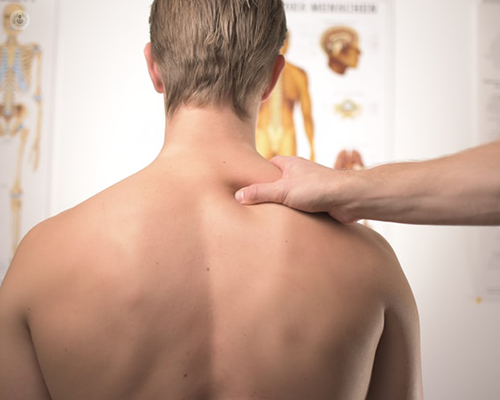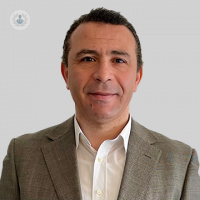Is thoracic outlet syndrome (TOS) serious?
Written in association with:The thoracic outlet is the space through which the nerves and vessels pass between the lower part of the neck and the armpit. It is limited by the collar bone, first rib and muscle structures. If this space is narrow (anatomically or due to other reasons), this can cause pressure on the nerves, artery or vein causing a variety of symptoms known as thoracic outlet syndrome (TOS).
We were fortunate enough to ask one of our top vascular surgeons Mr Mohamed Abdelhamid all about TOS, including the different types, causes and symptoms.

What causes TOS?
The compression on the nerves could be due to congenital causes due to abnormal muscle structure of the neck, an extra rib from the lowest neck vertebra, abnormal fibrous band between the spine and the first rib or narrow space under the first rib. Another cause could be a neck or upper arm injury that has caused a muscle spasm or scarring.
Some jobs that require prolonged elevation of both upper limbs above the head, for example, the mechanics or stocking shelves, can cause repeated prolonged narrowing of the thoracic outlet space leading to repeated prolonged compression of the nerves or the vascular structures.
Is TOS a serious condition?
TOS could cause serious and life-changing effects if left untreated and led to complications.
What are the three types of thoracic outlet syndrome (TOS)?
Based on the symptoms and pressure on different structures, there are three subtypes of TOS; neurogenic, venous or arterial TOS. I’ll explain their symptoms here:
Neurogenic TOS
This is the most common type of TOS accounting for 95% of cases. This happens due to compression of the brachial plexus, which is the set of nerves that come from the spinal cord to control the function and sensation of the upper limb.
Symptoms of neurogenic TOS include pain, numbness or pins and needles sensation in the neck, shoulder, arm or hand. Long-standing cases can cause weak grip or muscle wasting.
Venous TOS
This happens due to compression of the subclavian vein.
Symptoms of venous TOS include heaviness, swelling and bluish colour of the upper limb, especially with manual activity. Prolonged cases can lead to a blood clot in the vein causing arm deep vein thrombosis (DVT) that is also known as Paget-Schroetter syndrome.
Arterial TOS
This occurs due to compression of the subclavian artery that can cause tight narrowing of the artery with the development of swelling of the artery (aneurysm) due to the turbulent flow. This narrowing and swelling (post-stenotic dilatation) can cause precipitation of clots that can block the blood flow to the hand.
Symptoms of arterial TOS include sudden onset of hand pain, weakness, numbness, cold and pale hand or fingers and ulceration or wounds in the fingers.
What happens if TOS is left untreated?
Left untreated, TOS can cause chronic changes and symptoms that vary according to the type and structures being compressed. Let’s look at each type:
Neurogenic TOS
Chronic symptoms due to neurogenic TOS can be very debilitating due to chronic pain syndrome. Prolonged compression on the nerves can cause wasting and weakness of the muscles of the hand and arm leading to early fatigue and a weak grip. This can eventually cause inability to work using this hand.
Venous TOS
Chronic repetitive compression of the subclavian vein can cause narrowing and scarring of the vein with the development of small veins (collaterals) to divert the blood flow. That narrowing scarring can eventually lead to the development of blood clot (DVT).
This could be dangerous due to the possibility of blood clots going to the lungs. Any upper limb DVT should be treated and investigated as Venous TOS until proven otherwise.
Arterial TOS
Left untreated, this can cause symptoms of peripheral arterial disease (PAD) in the form of weakness of the arm muscles with manual activity or exercise, pale and cold hand, pain in the hand at rest and non-healing wounds or ulcerations in the fingers.
This can lead to gangrene of the tips of the finger/s especially in patients with diabetes or chronic kidney disease. Sudden embolization (blocking of the arteries due to shower of clots) can cause gangrene and loss of the hand if not treated.
What can help with TOS pain?
Early recognition and diagnosis of TOS can help to improve the success of management. Postural exercises and physiotherapy are the most common methods to improve the pain due to TOS. This can increase the range of movement of the neck and shoulder as well as increase the muscle strength and correct the posture.
Pain killers and muscle relaxants (prescribed by your doctor) can also help by treating any inflammation, reducing pain and allow muscle relaxation.
What makes TOS symptoms worse?
Misdiagnosis or mistreatment can lead to a prolonged period of suffering and/or pain. Poor posture (shoulder drooping or forward head position), prolonged repeated activity, obesity and lack of exercise can all worsen symptoms of TOS.
Mr Abdelhamid specialises in treating varicose veins, spider veins, aortic aneurysms and TOS. You can book an appointment to see him via his Top Doctor’s profile here.


